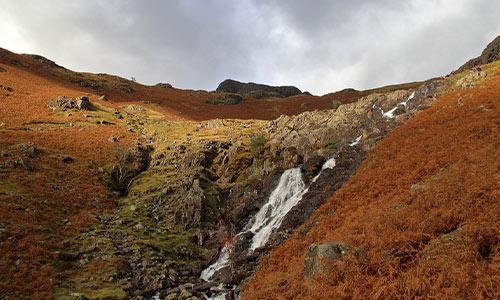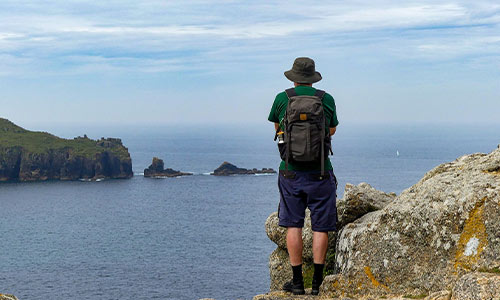A Guide to Plan the Perfect Coast-to-Coast Walk
Author

Mike has a real passion for cycling, hiking and just generally being outdoors. Being from Warrington, he is only a few hours away from North Wales, The Peak District, Yorkshire and the Lake District. He has climbed Mount Kilimanjaro and done a lot of the mountains in the Lake District. His new passion is walking his dog and enjoying a pint at the end.
The coast-to-coast walk is a popular long-distance walking route in England. With 192 miles of distance, the route crosses the country coast to coast, starting at St Bees Head in Cumbria and finishing at Robin Hood's Bay in Yorkshire. It's a great way to see the country, get some exercise, and clear your head. But it's not something you just wake up one day and do. It takes months of planning, preparation, and training.
I did a lot of research before undertaking this journey. I read books and articles, spoke to people who had done the walk, and meticulously planned my route and accommodation. In this blog post, I'm going to share with you everything I learned in the hope that it will help you if you're planning on doing the walk yourself.
Choose your route
There are several long-distance trails that crisscross the country, so you'll need to decide which one is right for you. Consider factors like climate, scenery, difficulty, and length when making your decision. Once you've settled on a route, map out your proposed itinerary and make sure you have an exit strategy in case of emergencies.

I chose the most popular route, which starts at St Bees Head in Cumbria and ends at Robin Hood's Bay in Yorkshire. This route takes you through some of England's most stunning scenery, including the Yorkshire Dales National Park and Lake District National Park.
Make your travel arrangements
One of the most important things to do when planning your Coast to Coast walk is to map out an itinerary. This will help you determine how long it will take you to complete the walk and book your accommodation accordingly. It's also a good idea to have a backup plan in case you get injured or need to take a break for any other reason.
Once you've decided on your start and end points, it's time to start thinking about accommodation and transport. If you're planning on walking the entire route, you'll need to book accommodation along the way. There are plenty of hostels, such as YHA Ennerdale, YHA Honister Hause, and Keld Bunkhouse, available along the route, so finding somewhere to stay shouldn't be a problem.
As for transport, you'll need to arrange how you're going to get to your start point and back from your endpoint. If you're driving yourself, you'll need to think about where you're going to leave your car during the walk. If you're using public transport, you'll need to check train and bus timetables in advance.
Coast-to-Coast transportation
If you're not starting from Cumbria or Yorkshire, you'll need to get transport to/from those locations. There are plenty of bus and train services that run between major cities in England (e.g., London, Manchester, and Birmingham).
You can rely on guidebooks and maps
I would highly recommend getting a guidebook (I used A Coast To Coast Walk) and a map (I used OS Explorer OL19) before starting your walk. These will be invaluable resources throughout the journey. You can buy them online or from most major bookstores in England.

Work on your map and compass skills
Finally, it's important that you learn to read a map and use a compass before embarking on your journey. This skill will come in handy if you get lost (which is bound to happen at some point). There are plenty of resources available online that can teach you how to use a compass (e.g., YouTube videos and blog posts). Alternatively, some outdoor stores offer classes on map reading and compass usage.
A coast-to-coast walk is an incredible experience that everyone should try at least once in their life. We hope these tips have helped give you some ideas about how to plan your own perfect coast-to-coast walk! Just remember to be patient, research in advance, pack light but carefully, and enjoy yourself.
-
 Regatta Unisex Ultralite 2 Pack Lightweight Walking Pole£23.40RRP £40.00 Save Up To £16.60
Regatta Unisex Ultralite 2 Pack Lightweight Walking Pole£23.40RRP £40.00 Save Up To £16.60
Author

Mike has a real passion for cycling, hiking and just generally being outdoors. Being from Warrington, he is only a few hours away from North Wales, The Peak District, Yorkshire and the Lake District. He has climbed Mount Kilimanjaro and done a lot of the mountains in the Lake District. His new passion is walking his dog and enjoying a pint at the end.
Categories
- Sport (28)
- Product Reviews (3)
- Team Outdoor Look (7)
- Mike Wild (2)
- Mike Payton (2)
- Suse Hammond-Pears (3)
- Snowboarding (12)
- Latest Offers (105)
- Shop Talk (1)
- Competitions (7)
- Walking (413)
- Lifestyle Fashion (8)
- Travel (86)
- Kit Guides (176)
- Workwear Clothing (6)
- Safety Workwear (4)
- Health/Fitness (289)
- Skiing (91)
- Great Outdoors (1316)
- Cycling (92)
- January 2025
- December 2024
- November 2024
- October 2024
- September 2024
- August 2024
- July 2024
- June 2024
- May 2024
- April 2024
- March 2024
- February 2024
- January 2024
- December 2023
- November 2023
- October 2023
- September 2023
- August 2023
- July 2023
- June 2023
- May 2023
- April 2023
- March 2023
- February 2023
- January 2023
- December 2022
- November 2022
- October 2022
- September 2022
- August 2022
- July 2022
- June 2022
- May 2022
- April 2022
- March 2022
- February 2022
- January 2022
- December 2021
- November 2021
- October 2021
- September 2021
- August 2021
- July 2021
- June 2021
- May 2021
- April 2021
- March 2021
- February 2021
- January 2021
- December 2020
- November 2020
- October 2020
- September 2020
- August 2020
- July 2020
- June 2020
- May 2020
- April 2020
- March 2020
- February 2020
- January 2020
- December 2019
- November 2019
- October 2019
- September 2019
- August 2019
- July 2019
- June 2019
- May 2019
- April 2019
- March 2019
- February 2019
- January 2019
- December 2018
- November 2018
- October 2018
- September 2018
- August 2018
- July 2018
- June 2018
- May 2018
- April 2018
- March 2018
- February 2018
- January 2018
- December 2017
- November 2017
- October 2017
- September 2017
- August 2017
- July 2017
- June 2017
- May 2017
- April 2017
- March 2017
- February 2017
- January 2017
- December 2016
- November 2016
- October 2016
- September 2016
- August 2016
- July 2016
- June 2016
- May 2016
- April 2016
- March 2016
- February 2016
- January 2016
- December 2015
- November 2015
- October 2015
- September 2015
- August 2015
- July 2015
- June 2015
- May 2015
- April 2015
- March 2015
- February 2015
- January 2015
- December 2014
- November 2014
- October 2014
- September 2014
- August 2014
- July 2014
- June 2014
- May 2014
- April 2014
- March 2014
- February 2014
- January 2014
- December 2013
- November 2013
- October 2013
- September 2013
- August 2013
- July 2013
- June 2013
- May 2013
- April 2013
- March 2013
- February 2013
- January 2013
- December 2012
- November 2012
- October 2012
- September 2012
- August 2012
- July 2012
- June 2012
- May 2012
- April 2012
- March 2012
- February 2012
- January 2012
- December 2011
- November 2011
- October 2011
- September 2011
- August 2011
- May 2010
- April 2010
- March 2010
- February 2010
- January 2010
- November 2009
- October 2009
- September 2009


Submit a Comment